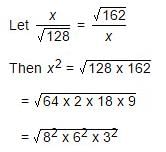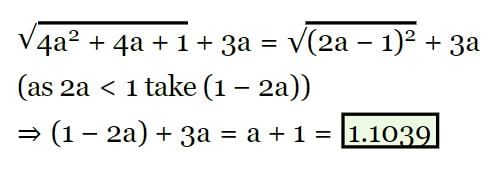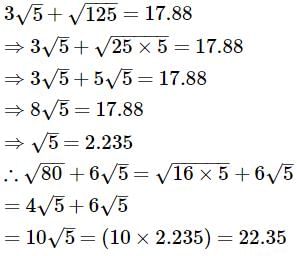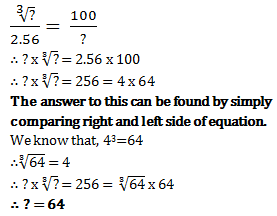All Exams >
Interview Preparation >
Quantitative Aptitude (Quant) >
All Questions
All questions of Square Root and Cube Root for Interview Preparation Exam

- a)2.24
- b)1.24
- c)1.34
- d)2.34
Correct answer is option 'D'. Can you explain this answer?
a)
2.24
b)
1.24
c)
1.34
d)
2.34

|
Pathways Academy answered |
(5.4756)1/2 = 2.34
Can you explain the answer of this question below:
- A:
0.1
- B:
10
- C:
10000
- D:
1000
The answer is C.
0.1
10
10000
1000
|
|
Juhi Desai answered |

Squaring both side,
⇒ 0.000256 x a = 2.56
⇒ a = 2.56/0.000256
⇒ a = 10000
Practice Quiz or MCQ (Multiple Choice Questions) with solution are available for Practice, which would help you prepare for "Square Root and Cube Root" under Logical Reasoning and Data Interpretative. You can practice these practice quizzes as per your speed and improvise the topic. The same topic is covered under various competitive examinations like - CAT, GMAT, Bank PO, SSC and other competitive examinations.Q.
- a)24
- b)12
- c)48
- d)36
Correct answer is 'A'. Can you explain this answer?
Practice Quiz or MCQ (Multiple Choice Questions) with solution are available for Practice, which would help you prepare for "Square Root and Cube Root" under Logical Reasoning and Data Interpretative. You can practice these practice quizzes as per your speed and improvise the topic. The same topic is covered under various competitive examinations like - CAT, GMAT, Bank PO, SSC and other competitive examinations.
Q.
a)
24
b)
12
c)
48
d)
36

|
Shalini Kumar answered |

⇒ x2 = √331776
⇒ x2 = 576
⇒ x = √576
⇒ x = 24

- a)0.85
- b)0.72
- c)2.8
- d)0.4
Correct answer is option 'A'. Can you explain this answer?
a)
0.85
b)
0.72
c)
2.8
d)
0.4

|
Pioneer Academy answered |

= (12/11) x (11/15) x (15/14)
= 12/14
= 0.85
The square root of 16641 is- a)129
- b)121
- c)211
- d)229
Correct answer is option 'A'. Can you explain this answer?
The square root of 16641 is
a)
129
b)
121
c)
211
d)
229
|
|
Nikita Singh answered |
Step 1:
- We now need to obtain the digital root of the number. Here's how you do it:
- Split the number up and add each digit together:
1 + 6 + 6 + 4 + 1 = 18 - If the answer is more than one digit, you would add each digit of the answer together again:
1 + 8 = 9 - What is the digital root of number 16,641?
Answer: 9
Step 2:
- So now we know the digital root of 16,641 is 9. Is 9 in the list of digital roots that are always a square root (1, 4, 7 or 9)?
- Answer: YES, 9 is in the list of digital roots that are always perfect squares. We can conclude that 16,641 could be a perfect square!
Factoring
- OK, so now we know that 16,641 could be a perfect square. We have to find the factors of the number to be sure.
- Here are all of the factors of 16,641:
(1 x 16,641) (3 x 5,547) (9 x 1,849) (43 x 387) (129 x 129)
Hence the answer is 129.

- a)10
- b)1
- c)0.1
- d)None of these
Correct answer is option 'B'. Can you explain this answer?
a)
10
b)
1
c)
0.1
d)
None of these

|
BT Educators answered |

Squaring both side,
⇒ 0.0576 x a = 0.0576
⇒ a = 1
Can you explain the answer of this question below:
- A:

- B:
7/36
- C:
36/7
- D:

The answer is c.
7/36
36/7
|
|
Meera Rana answered |

► Using identity, (a-b)2 = a2 + b2 - 2ab
► Here a = √7 and b = 1/√7

= (√7)2 + (1/√7)2 - 2. √7.1/√7
= 7 + 1/7 - 2
= 5 + 1/7
= 36/7
The least perfect square, which is divisible by each of 21, 36 and 66 is:- a)213444
- b)214344
- c)214434
- d)231444
Correct answer is option 'A'. Can you explain this answer?
The least perfect square, which is divisible by each of 21, 36 and 66 is:
a)
213444
b)
214344
c)
214434
d)
231444

|
Ishani Rane answered |
L.C.M of 21,36,66=2772
Now, 2772=2*2*3*3*7*11
Hence to make it a perfect square , it must be multiplied by 7*11
∴ The required number is 2^2*3^3*7^2*11^2
= 213444
If the product of three consecutive positive integers is 15600 then the sum of the squares of these integers is - a)1777
- b)1785
- c)1875
- d)1877
Correct answer is option 'D'. Can you explain this answer?
If the product of three consecutive positive integers is 15600 then the sum of the squares of these integers is
a)
1777
b)
1785
c)
1875
d)
1877
|
|
Aravind Mehta answered |
Finding the Consecutive Integers
To determine three consecutive positive integers whose product equals 15600, we can denote them as n, n+1, and n+2.
Calculating the Approximate Value of n
1. Start with the equation: n(n + 1)(n + 2) = 15600.
2. To estimate n, we can take the cube root of 15600.
- The cube root of 15600 is approximately 24.
- Thus, we can start checking integers around this value.
Testing Consecutive Integers
1. Testing n = 24:
- The integers are 24, 25, and 26.
- Their product: 24 * 25 * 26 = 15600 (correct).
Calculating the Sum of Squares
Now, we need to find the sum of the squares of these integers:
1. The integers are 24, 25, and 26.
2. Calculating the squares:
- 24^2 = 576
- 25^2 = 625
- 26^2 = 676
Summing the Squares
- Now, add these squares together:
- 576 + 625 + 676 = 1877.
Conclusion
The sum of the squares of the integers 24, 25, and 26 is 1877.
Thus, the correct answer is option 'D'.
To determine three consecutive positive integers whose product equals 15600, we can denote them as n, n+1, and n+2.
Calculating the Approximate Value of n
1. Start with the equation: n(n + 1)(n + 2) = 15600.
2. To estimate n, we can take the cube root of 15600.
- The cube root of 15600 is approximately 24.
- Thus, we can start checking integers around this value.
Testing Consecutive Integers
1. Testing n = 24:
- The integers are 24, 25, and 26.
- Their product: 24 * 25 * 26 = 15600 (correct).
Calculating the Sum of Squares
Now, we need to find the sum of the squares of these integers:
1. The integers are 24, 25, and 26.
2. Calculating the squares:
- 24^2 = 576
- 25^2 = 625
- 26^2 = 676
Summing the Squares
- Now, add these squares together:
- 576 + 625 + 676 = 1877.
Conclusion
The sum of the squares of the integers 24, 25, and 26 is 1877.
Thus, the correct answer is option 'D'.
The cube root of 0.000729 is- a)0.09
- b)0.9
- c)0.21
- d)0.11
Correct answer is option 'A'. Can you explain this answer?
The cube root of 0.000729 is
a)
0.09
b)
0.9
c)
0.21
d)
0.11

|
Elite Coaching Classes answered |
To find the cube root of 0.000729, we recognize that 0.000729 can be expressed as (0.09)3.
Therefore, the cube root of 0.000729 is 0.09, which confirms that option 1 (0.09), is the correct answer.
Therefore, the cube root of 0.000729 is 0.09, which confirms that option 1 (0.09), is the correct answer.
Practice Quiz or MCQ (Multiple Choice Questions) with solutions are available for Practice, which would help you prepare for "Square Root and Cube Root" under Quantitative Aptitude. You can practice these practice quizzes as per your speed and improvise the topic. The same topic is covered under various competitive examinations like - CAT, GMAT, Bank PO, SSC and other competitive examinations. Q. The cube root of .000216 is:- a)0.6
- b)0.06
- c)77
- d)87
Correct answer is option 'B'. Can you explain this answer?
Practice Quiz or MCQ (Multiple Choice Questions) with solutions are available for Practice, which would help you prepare for "Square Root and Cube Root" under Quantitative Aptitude. You can practice these practice quizzes as per your speed and improvise the topic. The same topic is covered under various competitive examinations like - CAT, GMAT, Bank PO, SSC and other competitive examinations.
Q. The cube root of .000216 is:
a)
0.6
b)
0.06
c)
77
d)
87

|
Impact Learning answered |
We need to find the cube root of 0.000216.
Step 1: Convert the decimal to a fraction:
0.000216 = 216 / 1000000
0.000216 = 216 / 1000000
Step 2: Take the cube root of both numerator and denominator:
∛(216 / 1000000) = ∛216 / ∛1000000
∛(216 / 1000000) = ∛216 / ∛1000000
- Cube root of 216 = 6 (since 6 × 6 × 6 = 216)
- Cube root of 1000000 = 100 (since 100 × 100 × 100 = 1000000)
So,
∛0.000216 = 6 / 100 = 0.06
∛0.000216 = 6 / 100 = 0.06

- a)0.1
- b)10
- c)10000
- d)1000
Correct answer is 'C'. Can you explain this answer?
a)
0.1
b)
10
c)
10000
d)
1000

|
Janhavi Yadav answered |

Squaring both side,
⇒ 0.000256 x a = 2.56
⇒ a = 2.56/0.000256
⇒ a = 10000
Chapter doubts & questions for Square Root and Cube Root - Quantitative Aptitude (Quant) 2025 is part of Interview Preparation exam preparation. The chapters have been prepared according to the Interview Preparation exam syllabus. The Chapter doubts & questions, notes, tests & MCQs are made for Interview Preparation 2025 Exam. Find important definitions, questions, notes, meanings, examples, exercises, MCQs and online tests here.
Chapter doubts & questions of Square Root and Cube Root - Quantitative Aptitude (Quant) in English & Hindi are available as part of Interview Preparation exam.
Download more important topics, notes, lectures and mock test series for Interview Preparation Exam by signing up for free.
Quantitative Aptitude (Quant)
164 videos|133 docs|118 tests
|

Contact Support
Our team is online on weekdays between 10 AM - 7 PM
Typical reply within 3 hours
|
Free Exam Preparation
at your Fingertips!
Access Free Study Material - Test Series, Structured Courses, Free Videos & Study Notes and Prepare for Your Exam With Ease

 Join the 10M+ students on EduRev
Join the 10M+ students on EduRev
|

|
Create your account for free
OR
Forgot Password
OR
Signup to see your scores
go up
within 7 days!
within 7 days!
Takes less than 10 seconds to signup


 is:
is:








 then the value of (x2 + y2) is:
then the value of (x2 + y2) is: is
is









